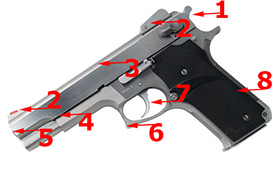Learn
Firearms Examiners
Firearms examiners are not only responsible for examining firearms but also tool marks. They can restore serial numbers on guns that have been scratched off and can determine if a bullet from a crime scene was fired from a suspect's gun.
Many people believe that firearms and ballistics are the same thing, but they are not.
Ballistics deals more with the flight and behavior of projectiles especially bullets.
Firearm examiners are responsible for comparing bullets found at a crime scene. Read this job description. It will help you understand some of the jobs a firearm examiner is responsible for on a day-to-day basis.
To better understand how firearms are examined, let's make sure you understand the type of firearms, parts of a gun, parts of a bullet and shotgun shell, and types of bullets.
Handguns are designed to be fired with one hand.
A revolver has a hammer that pulls back when the trigger is pulled or can be pulled back manually. Bullets rotate in the cylinder to bring one to the barrel.

1 - grip 2 - trigger 3 - trigger guard 4 - cylinder 5 - muzzle 6 - sight 7 - barrel 8 - hammer 9 - cylinder release
A semiautomatic handgun holds more ammunition than a revolver. The hammer strikes the bullet case when the trigger is pulled. The bullet casing is automatically ejected. The barrel is rifled.

1 - hammer 2 - sight 3 - slide 4 - barrel 5 - muzzle 6 - trigger guard 7 - trigger 8 - grip
A rifle fires a bullet similar to a handgun. The hammer strikes a bullet case when the trigger is pulled. The bullet casing can be manually or automatically ejected. The barrel is rifled.

1 - butt 2 - stock 3 - trigger guard 4 - trigger 5 - chamber 6 - barrel 7 - muzzle 8 - sights 9 - safety
Shotguns have similar parts of a rifle, except for a smooth barrel. Shotguns also use a different type of ammunition.
Two types of barrels of firearms include: smooth and rifled. A smooth barrel consists of a hollow tube that is smooth and does not have lands and grooves cut in it. Smooth barrels are found in shotguns. A rifled barrel consists of a hollow tube that has spiral grooves that are cut into the interior side. The spiral grooves create lands raised areas between the grooves in a barrel or bullet casing and grooves indentions between the raised lands in a barrel or bullet casing that in turn create striations small unique scratches created on a bullet when it is fired from a gun . Each type of gun has its own rifling process that determine many characteristics including how many lands and grooves, the width of lands and grooves, their direction of twist, and the angle of the twist.
Three types of bullets include:
- lead or lead alloy - a softer bullet
- semi-jacketed - covered in a brass jacket except the tip
- full metal jacket - a lead bullet completely covered with brass
A bullet has four main parts:
1 - bullet - Also called the projectile, the bullet exits the barrel of the gun after the propellant ignites and causes an explosion.
2 - cartridge - Also called the casing, the cartridge is ejected after firing and often left behind at a crime scene.
3 - propellant - The propellant ignites from a spark to propel the bullet out of the barrel.
4 - primer - When the trigger is bulled, the firing pin strikes the primer to create a spark to ignite the propellant.
A shotgun shell has two main parts:
1 - shot (pellets) - The shot projects out when the propellant ignites and causes an explosion. The shot are many small round pellets in place of a bullet.
2 - wad (plastic) - The wad holds the shot together until it exits the barrel.
Use these resources to learn more.
- Principles of Firearms Examination - to learn more about firearms identification
- Firearms Tutorial - to learn more terminology
- Basic Bullet Sizes, Calibers, and Types, Explained - to learn more about bullets
- Back to Basics: Rifling - to learn more about rifling which is found in the barrel
When firearms evidence is collected, it is important that forensic scientists use rubber-tipped forceps to avoid creating added striations during collection. Forensic scientists will use a comparison microscope to compare two pieces of evidence at one time. A comparison microscope can be used to look at the striae on two different bullets simultaneously to see if there is a match. a forensic scientist will also determine all class and individual characteristics while analyzing the evidence.
Class characteristics include:
- type of gun,
- manufacturer of gun,
- caliber size of the bullet,
- bullet manufacturer,
- number of lands and grooves,
- size of lands and grooves,
- direction of rifling twist,
- degree of twist,
- firing pin location,
- size and shape,
- extractor/ejector size, and
- location.
Individual characteristics include:
- striations on a bullet,
- extractor/ejector marks,
- chamber marks,
- firing pin impression marks, and
- breech marks.

